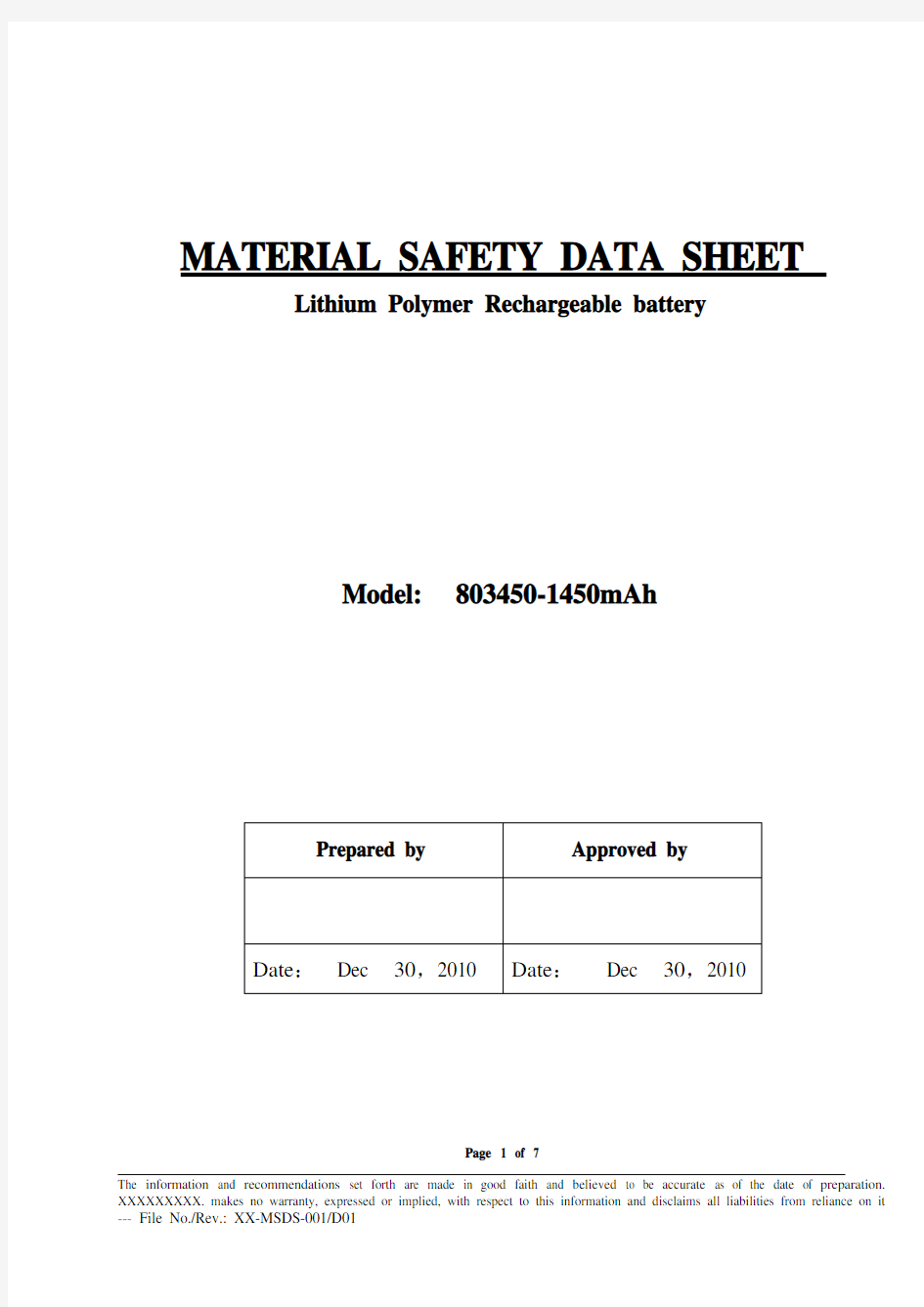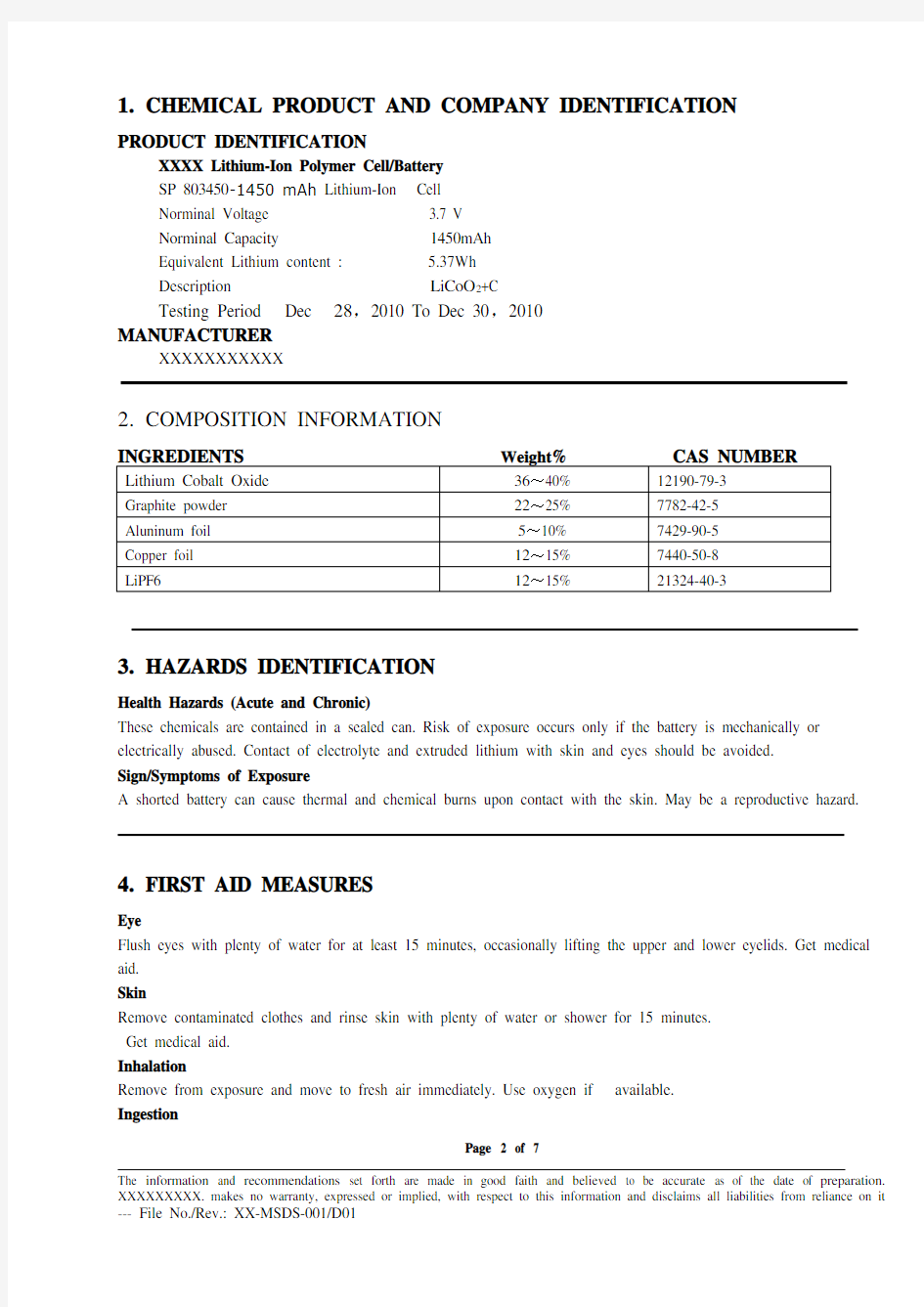

MATERIAL SAFETY DATA SHEET Lithium Polymer Rechargeable battery
Model: 803450-1450mAh
Page 1 of 7
1.CHEMICAL PRODUCT AND COMPANY IDENTIFICATION
PRODUCT IDENTIFICATION
XXXX Lithium-Ion Polymer Cell/Battery
SP 803450-1450 mAh Lithium-Ion Cell
Norminal Voltage 3.7 V
Norminal Capacity 1450mAh
Equivalent Lithium content : 5.37Wh
Description LiCoO2+C
Testing Period Dec 28,2010 To Dec 30,2010
MANUFACTURER
XXXXXXXXXXX
https://www.doczj.com/doc/cb14660655.html,POSITION INFORMATION
3.HAZARDS IDENTIFICATION
Health Hazards (Acute and Chronic)
These chemicals are contained in a sealed can. Risk of exposure occurs only if the battery is mechanically or electrically abused. Contact of electrolyte and extruded lithium with skin and eyes should be avoided.
Sign/Symptoms of Exposure
A shorted battery can cause thermal and chemical burns upon contact with the skin. May be a reproductive hazard.
4.FIRST AID MEASURES
Eye
Flush eyes with plenty of water for at least 15 minutes, occasionally lifting the upper and lower eyelids. Get medical aid.
Skin
Remove contaminated clothes and rinse skin with plenty of water or shower for 15 minutes.
Get medical aid.
Inhalation
Remove from exposure and move to fresh air immediately. Use oxygen if available.
Ingestion
Page 2 of 7
Give at least 2 glasses of milk or water. Induce vomiting unless patient is unconscious.
Call a physician.
5.FIRE FIGHTING MEASURES
Flash Point: N/A.
Auto-Ignition Temperature: N/A.
Extinguishing Media
Water, CO2.
Special Fire-Fighting Procedures
Self-contained breathing apparatus.
Unusual Fire and Explosion Hazards
Cell may vent when subjected to excessive heat-exposing battery contents.
Hazardous Combustion Products
Carbon monoxide, carbon dioxide, lithium oxide fumes.
.
6.ACCIDENTAL RELEASE MEASURES
Steps to be Taken in case Material is Released or Spilled
If the battery material is released, remove personnel from area until fumes dissipate. Provide maximum ventilation to clear out hazardous gases. Wipe it up with a cloth, and dispose of it in a plastic bag and put into a steel can. The preferred response is to leave the area and allow the battery to cool and vapors to dissipate. Provide maximum ventilation. Avoid skin and eye contact or inhalation of vapors. Remove spilled liquid with absorbent and incinerate. Waste Disposal Method
It is recommended to discharge the battery to the end, to use up the metal lithium inside the battery, and to bury the discharged battery in soil.
7.HANDLING AND STORAGE
The battery should not be opened, destroyed or incinerate, since they may leak or rupture and release to the environment the ingredients that they contain in the hermetically sealed container.
Do not short circuit terminals, or over charge the battery, forced over-discharge, throw to fire. Do not crush or puncture the battery, or immerse in liquids.
Precautions to be taken in handling and storing
Avoid mechanical or electrical abuse. Storage preferably in cool, dry and ventilated area, which is subject to little temperature change. Storage at high temperatures should be avoided.
Do not place the battery near heating equipment, nor expose to direct sunlight for long periods.
Other Precautions
The battery may explode or cause burns, if disassembled, crushed or exposed to fire or high temperatures. Do not short or install with incorrect polarity.
Page 3 of 7
8.Exposure controls/personal protection
Respiratory Protection
In case of battery venting, provide as much ventilation as possible. Avoid confined areas with venting cell cores. Respiratory Protection is not necessary under conditions of normal use.
Ventilation
Not necessary under conditions of normal use.
Protective Gloves
Not necessary under conditions of normal use.
Other Protective Clothing or Equipment
Not necessary under conditions of normal use.
Personal Protection is recommended for venting battery
Respiratory Protection, Protective Gloves, Protective Clothing and safety glass with side shields.
9.Physical and chemical properties
Appearance characters:Silvery-white, prismatic, odorless, solid battery.
Chemical Uses: Digital electronic products.
10.S TABILITY AND REACTIVITY
Stability
Stable
Conditions to Avoid
Heating, mechanical abuse and electrical abuse.
Hazardous Decomposition Products
N/A.
Hazardous Polymerization
N/A.
If leaked, forbidden to contact with strong oxidizers, mineral acids, strong alkalies, halogenated hydrocarbons.
11.T OXCOLOGICAL INFORMATION
Inhalation, skin contact and eye contact are possible when the battery is opened.
Exposure to internal contents, the corrosive fumes will be very irritating to skin, eyes and mucous membranes. Overexposure can cause symptoms of non-fibrotic lung injury and membrane irritation.
Page 4 of 7
12.E COLOGICAL INFORMATION
Lithium polymer batteries do not contain heavy metals as defined by the European directives 2006/66/EC Article 21. Mercury has not been “intentionally introduced (as distinguished from mercury that may be incidentally present in other materials)” in the sense of the U.S.A. “Mercury-Containing and Rec hargeable Battery Management Act?? (May 13 1996).
The Regulation on Mercury Content Limitation for Batteries promulgated on 1997-12-31 by the China authorities including the State Administration of Light Industry and the State Environmental Protection Administration defines …low mercury? as …mercury content by weight in battery as less than 0.025%?, and …mercury free? as …mercury content by
weight in battery as less than 0.0001%?. And therefore: Springpower lithium polymer batteries belong to the category of mercury-free battery (mercury content lower than 0.0001%).
13.D ISPOSAL CONSIDERATIONS
USA: Lithium polymer batteries are classified by the federal government as non-hazardous waste and are
safe for disposal in the normal municipal waste stream. These batteries, however, do contain recyclable materials and are accepted for recycling by the Rechargeable Battery Recycling Corporation's (RPBC) Battery Recycling Program. Please go to the RPRC website at https://www.doczj.com/doc/cb14660655.html, for additional information.
In the European Union, manufacturing, handling and disposal of batteries is regulated on the basis of the DIRECTIVE 2006/66/EC OF THE EUROPEAN PARLIAMENT AND OF THE COUNCIL of 6 September 2006 on batteries and accumulators and waste batteries and accumulators and repealing Directive 91/157/EEC. Customers find detailed information on disposal in their specific countries using the web site of the European Portable Batteries Association (https://www.doczj.com/doc/cb14660655.html,/legislation_national.html ).
Importers and users outside EU should consider the local law and rules.
In order to avoid short circuit and heating, used lithium polymer batteries should never be stored or transported in bulk. Proper measures against short circuit are:
●Storage of batteries in original packaging
●Coverage of the terminals
●Embedding in dry sand
14.R EGULATORY INFORMATION
Marking consideration: European Union: According to Directive 2006/66/EC, the batteries have to be
marked with the crossed wheel bin symbol.
Lithium ion batteries, which contain electronic modules (e.g. PCM) and
Page 5 of 7
which are subjected to the EMC directive 93/97/EEC, must be CE approved
and must wear the CE marking.
According to Dangerous Goods Regulations (see 15.) battery packs have to
be marked with the Watt-hour rating.
International safety standards: The basis cells are approved according to UL 1642
Water hazard class: (according to German Federal Water Management Act)
non-water pollution according to VwVwS Appendix 1
(No. 1443 and 766)
15.Transport information
For the international transport of lithium batteries, they must comply with these regulations: the International Maritime Dangerous Goods (IMDG) Code by International Maritime Organization (IMO), Dangerous Goods Regulations (DGR) by International Air Transport Association (IATA) and Technical Instructions for the Safe Transport of Dangerous Goods by Air (TI) by International Civil Aviation Organization (ICAO). These regulations are based on the UN Recommendations on the Transport of Dangerous Goods, Manual of Tests and Criteria.
Lithium batteries which meet the requirements of UN38.3 (UN Manual of Tests and Criteria, Part III, subsection 38.3) could be transported by air and by sea as ordinary goods, otherwise should be transported according to Class 9, Packing Group II hazardous goods.
As the published of the UN Recommendations on the Transport of Dangerous Goods, all these regulations have added some new contents to regulate the transport of lithium ion batteries. And they should be complied since 1 January 2009.
1.For lithium ion batteries, UN ID number is 3480. For lithium ion batteries contained in equipment or lithium
ion batteries packed with equipment, UN ID number is 3481.
2.The consignment should be fully described by proper shipping name and packed, marked and in proper
condition for carriage by air. The consignment is not classified as dangerous under the current edition of the IATA 51st Effective, Dangerous goods regulation and all applicable carrier and government regulations.
3. For transported by air, Lithium-ion Cells/Batteries shipped as “Not Restricted” Cargo:Must comply with
Section Ⅱ of P1965-P1967 accordingly; For cells, the Watt-hour rating should not be more than 20Wh; For batteries, the Watt-hour rating should not be more than 100Wh. Watt- hour rating must be marked on the outside of the battry case (marked by manufacturer). (Except those manufactured before 1 Janary 2009, which may be transported without this marking until 31 december 2010).
4. Each consignment must be accompanied with a document such as an air waybill with an indication. For those
Lithium ion cells/ batteries contained in equipment, the equipment must be equipped with an effective means of preventing accidental activation. The telephone number for additional information for XXXXXXX cells is +86-755-888888888.
5. Quantity per package shall not exceed 10kg.
6.Each package must be capable of withstanding a 1.2m drop test in any orientation without damage of cells or
batteries contained therein.
7. Lithium batteries which meet the requirements of A154 could be transported by air, and the batteries
manufactured by SPRINGPOWER meet these requirements.( A154 Lithium batteries identified by the manufacturer as being defective for safety reasons, or that have been damaged, that have the potential of producing a dangerous evolution of heat, fire or short circuit are forbidden for transport. )
Page 6 of 7
8. Cells and batteries must be protected so as to prevent short circuits. This includes protection against contact
with conductive meterials within the same packaging that could lead to short circuit.
16. Other Information
This information is not effective to all the batteries manufactured by XXXXXX. This information comes from reliable sources, but no warranty is made to the completeness and accuracy of information contained. SPRINGPOWER doesn?t assume responsibility for any damage or loss because of misuse of batteries. Users should grasp the correct use method and be responsible for the use of batteries.
Page 7 of 7